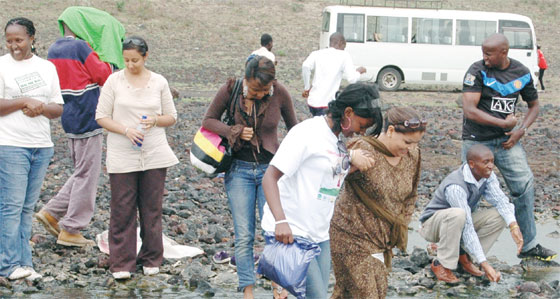By Harold Ayodo
It is midday and Milka Letole and her three-year-old baby lie in a hot spring adjacent to Lake Elementaita.
Tourists who have just returned from a sightseeing trip of the soda lake cannot resist the allure of the hot water oozing with apparent medicinal values. Their appetite for the steaming spring has the better of them.
After parking their van about 100 metres away, they quickly peel off their clothes, changing into swimming costumes. And in they plunge. No ceremonies. They swim and float on the warm water — between 30 and 40 degrees centigrade — for about 40 minutes. And off they go. This has become the norm now, and people have become accustomed to the bathes that all enjoy from the natural wonders of Etuk. |
Villages have a bath and wash clothes at the Kikopey Hot Spring. Photos: Jonah Onyango/Standard |
Relaxation
"I come here with my husband and children daily for relaxation, especially in the early morning and afternoon hours," says Letole, 38. Like Letole, many Etuk residents in users of the hot natural bathes. Residents and tourists often soak in the springs together, enjoying the natural springs bubbling with apparent irresistible medicinal values
Limousines parked only metres from the natural resource are a testimony that the high and lowly are equals here. "We’ve swum with senior government officials and businessmen," says Letole who has become regular at the springs. "Our parents brought us here to prevent skin infections. I now bring my four children here for the same reason."
Besides her children, Letole and her colleagues have made this a common hobby. They visit the place three times a week together, soaking themselves in the natural springs as they bond. Ms Joyce Lentutu, 40, says the Kikopey hot springs, locally referred to as maji moto (hot water), unites the locals.
"We meet here to enjoy the warm bathes," says Lentutu.
She says many find it hard to leave after the experience.
Mr Paolo Rossi, a tourist from Turin in Italy, says the natural warmth has better effects on the skin than artificially heated water. "We [friends and relatives] come to Kenya every year to see the wildlife and then relax here," says Rossi. Locals enjoy the warm water at no cost, a luxury that would cost them a fortune in saunas and jacuzzis. After all, this is all natural, apparently offering better values than those that may offered by jacuzzis. Despite what is to ordinary folk a natural spring, scientists offer disparate explanations on the source of the spring and its water.
Mr Francis Mwaura, a lecturer at the University of Nairobi’s Department of Geography, says heat from geothermal springs emerge from the crust of the earth.
"Volcanic belts, pockets of molten rock, transfer heat from one point to another. They heat water that infiltrates the zones," says Mwaura.
Water that seeps through the ground is often heated above boiling point and recovered through springs and wells.
Molten rock
"Geothermal systems constitute important resources in many countries where pipes deliver water of temperatures as high as 130 degrees centigrade," says Mwaura. The lecturer’s views are expressed in a research paper entitled A spatio-chemical survey of hydrogeothermal springs in Lake Elementaita, Kenya.
He says geothermal water heating for municipal households is common in Reykjavik in Iceland and Rotorua in New Zealand.
In addition, steam jets to the south of Lake Naivasha in Rift Valley are tapped to generate more than 45 mega watts of geothermal energy, says Mwaura.
The scholar, however, warns that geothermal water can dissolve and carry large amounts of chemicals from the rocks.
"This creates regional disparities in spring water composition, creating far reaching implications on water bodies," says Mwaura.
He argues that the eastern part of the Rift Valley is characterised by widespread geothermal activity. His research surveyed three areas of geothermal activity in Lake Elementaita basin. Results indicated warm temperatures of between 30 and 40 degrees centigrade. They also showed high concentrations of carbonates, chlorides and sulphates in the springs that are a significant source of water, especially during dry seasons. Despite the interest generated by the springs, however, Mwaura reckons that there is a "serious lack of scientific information on the thermal springs".
 The Standard Group Plc is a multi-media organization with investments in media
platforms spanning newspaper print operations, television, radio broadcasting,
digital and online services. The Standard Group is recognized as a leading
multi-media house in Kenya with a key influence in matters of national and
international interest.
The Standard Group Plc is a multi-media organization with investments in media
platforms spanning newspaper print operations, television, radio broadcasting,
digital and online services. The Standard Group is recognized as a leading
multi-media house in Kenya with a key influence in matters of national and
international interest.
 The Standard Group Plc is a multi-media organization with investments in media
platforms spanning newspaper print operations, television, radio broadcasting,
digital and online services. The Standard Group is recognized as a leading
multi-media house in Kenya with a key influence in matters of national and
international interest.
The Standard Group Plc is a multi-media organization with investments in media
platforms spanning newspaper print operations, television, radio broadcasting,
digital and online services. The Standard Group is recognized as a leading
multi-media house in Kenya with a key influence in matters of national and
international interest.










